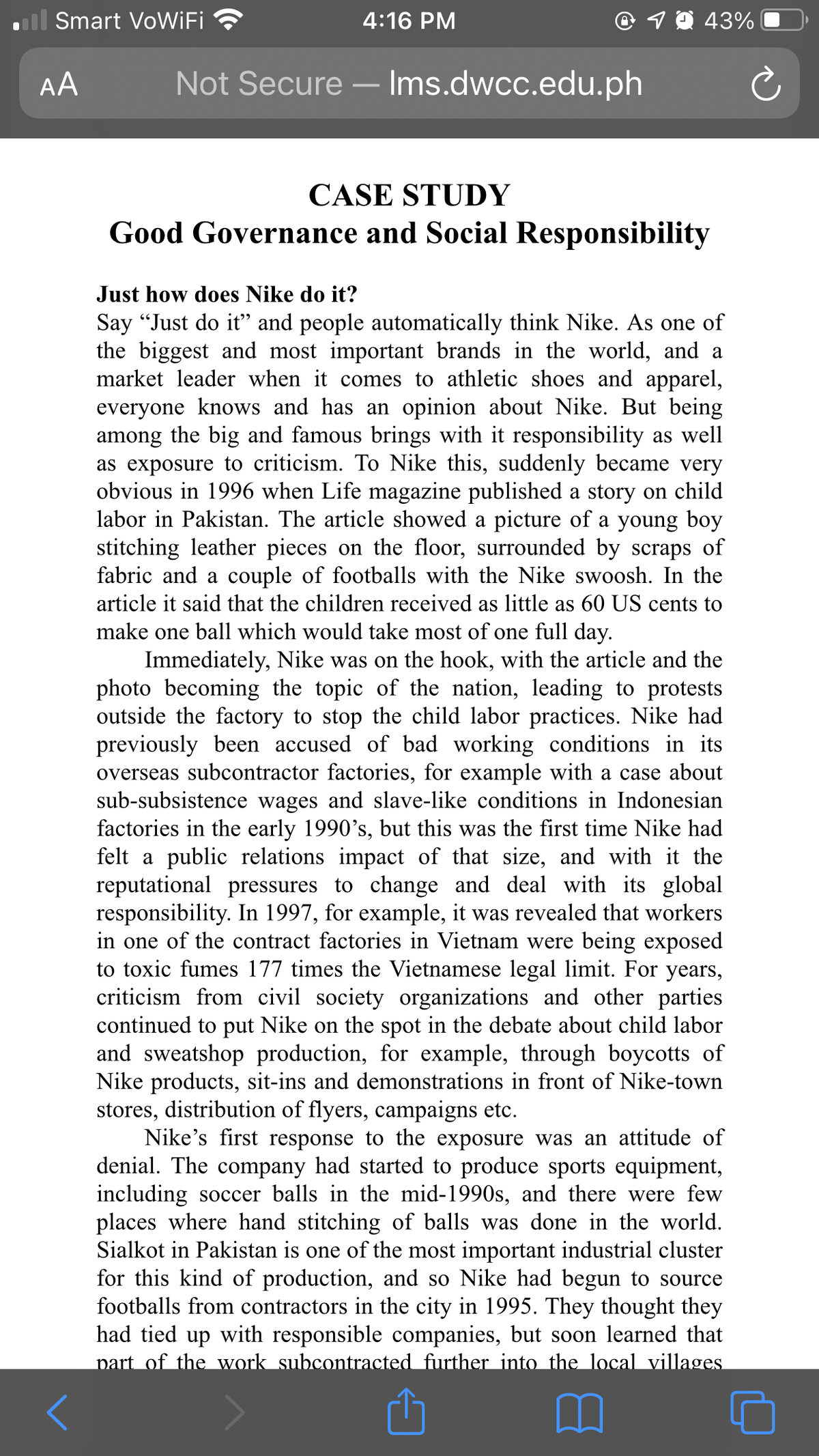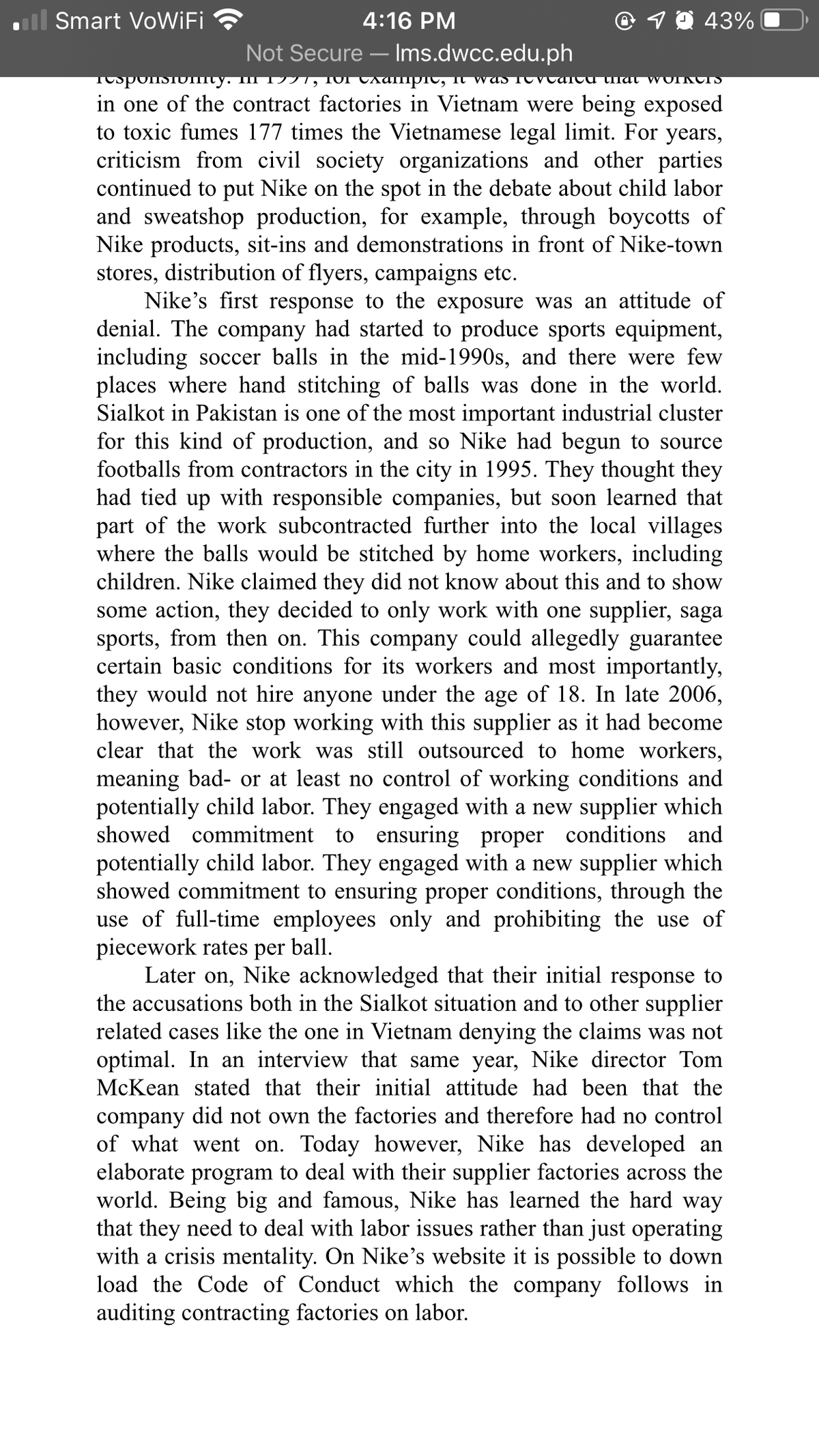What do you think of the different responses and actions Nike has shown to meet the challenges of production in developing countries over the years? * How can Nike and similar companies best avoid these kinds of cases? * What does Nike do today? (what change did it provoke in the company)? * Do you think a company like Nike will be able to change or impact the conditions in the communities and countries where they produce?
What do you think of the different responses and actions Nike has shown to meet the challenges of production in developing countries over the years? * How can Nike and similar companies best avoid these kinds of cases? * What does Nike do today? (what change did it provoke in the company)? * Do you think a company like Nike will be able to change or impact the conditions in the communities and countries where they produce?
Chapter4: Social Responsibility And Ethics In Marketing
Section4.2: Blue Bell Creameries Moo’ves Ahead After Listeria Crisis
Problem 3C
Related questions
Question
100%
* What do you think of the different responses and actions Nike has shown to meet the challenges of production in developing countries over the years?
* How can Nike and similar companies best avoid these kinds of cases?
* What does Nike do today? (what change did it provoke in the company)?
* Do you think a company like Nike will be able to change or impact the conditions in the communities and countries where they produce?

Transcribed Image Text:Smart VoWiFi
4:16 PM
19 43%
AA
Not Secure – Ims.dwcc.edu.ph
CASE STUDY
Good Governance and Social Responsibility
Just how does Nike do it?
Say “Just do it" and people automatically think Nike. As one of
the biggest and most important brands in the world, and a
market leader when it comes to athletic shoes and apparel,
everyone knows and has an opinion about Nike. But being
among the big and famous brings with it responsibility as well
as exposure to criticism. To Nike this, suddenly became very
obvious in 1996 when Life magazine published a story on child
labor in Pakistan. The article showed a picture of a young boy
stitching leather pieces on the floor, surrounded by scraps of
fabric and a couple of footballs with the Nike swoosh. In the
article it said that the children received as little as 60 US cents to
make one ball which would take most of one full day.
Immediately, Nike was on the hook, with the article and the
photo becoming the topic of the nation, leading to protests
outside the factory to stop the child labor practices. Nike had
previously been accused of bad working conditions in its
overseas subcontractor factories, for example with a case about
sub-subsistence wages and slave-like conditions in Indonesian
factories in the early 1990's, but this was the first time Nike had
felt a public relations impact of that size, and with it the
reputational pressures to change and deal with its global
responsibility. In 1997, for example, it was revealed that workers
in one of the contract factories in Vietnam were being exposed
to toxic fumes 177 times the Vietnamese legal limit. For years,
criticism from civil society organizations and other parties
continued to put Nike on the spot in the debate about child labor
and sweatshop production, for example, through boycotts of
Nike products, sit-ins and demonstrations in front of Nike-town
stores, distribution of flyers, campaigns etc.
Nike's first response to the exposure was an attitude of
denial. The company had started to produce sports equipment,
including soccer balls in the mid-1990s, and there were few
places where hand stitching of balls was done in the world.
Sialkot in Pakistan is one of the most important industrial cluster
for this kind of production, and so Nike had begun to source
footballs from contractors in the city in 1995. They thought they
had tied up with responsible companies, but soon learned that
part of the work subcontracted further into the local villages

Transcribed Image Text:ll Smart VoWiFi
4:16 PM
O 1 0 43%
Not Secure – Ims.dwcc.edu.ph
-
TospolsIoImy. III 17TT,
in one of the contract factories in Vietnam were being exposed
to toxic fumes 177 times the Vietnamese legal limit. For years,
criticism from civil society organizations and other parties
continued to put Nike on the spot in the debate about child labor
and sweatshop production, for example, through boycotts of
Nike products, sit-ins and demonstrations in front of Nike-town
stores, distribution of flyers, campaigns etc.
Nike's first response to the exposure was an attitude of
denial. The company had started to produce sports equipment,
including soccer balls in the mid-1990s, and there were few
places where hand stitching of balls was done in the world.
Sialkot in Pakistan is one of the most important industrial cluster
for this kind of production, and so Nike had begun to source
footballs from contractors in the city in 1995. They thought they
had tied up with responsible companies, but soon learned that
part of the work subcontracted further into the local villages
where the balls would be stitched by home workers, including
children. Nike claimed they did not know about this and to show
some action, they decided to only work with one supplier, saga
sports, from then on. This company could allegedly guarantee
certain basic conditions for its workers and most importantly,
they would not hire anyone under the age of 18. In late 2006,
however, Nike stop working with this supplier as it had become
clear that the work was still outsourced to home workers,
meaning bad- or at least no control of working conditions and
potentially child labor. They engaged with a new supplier which
showed commitment to ensuring proper conditions and
potentially child labor. They engaged with a new supplier which
showed commitment to ensuring proper conditions, through the
use of full-time employees only and prohibiting the use of
piecework rates per ball.
Later on, Nike acknowledged that their initial response to
the accusations both in the Sialkot situation and to other supplier
related cases like the one in Vietnam denying the claims was not
optimal. In an interview that same year, Nike director Tom
McKean stated that their initial attitude had been that the
CAanipTC, It waS TOVCATCU that WOIKCIS
company did not own the factories and therefore had no control
of what went on. Today however, Nike has developed an
elaborate program to deal with their supplier factories across the
world. Being big and famous, Nike has learned the hard way
that they need to deal with labor issues rather than just operating
with a crisis mentality. On Nike's website it is possible to down
load the Code of Conduct which the company follows in
auditing contracting factories on labor.
Expert Solution
This question has been solved!
Explore an expertly crafted, step-by-step solution for a thorough understanding of key concepts.
Step by step
Solved in 2 steps

Knowledge Booster
Learn more about
Need a deep-dive on the concept behind this application? Look no further. Learn more about this topic, management and related others by exploring similar questions and additional content below.Recommended textbooks for you

